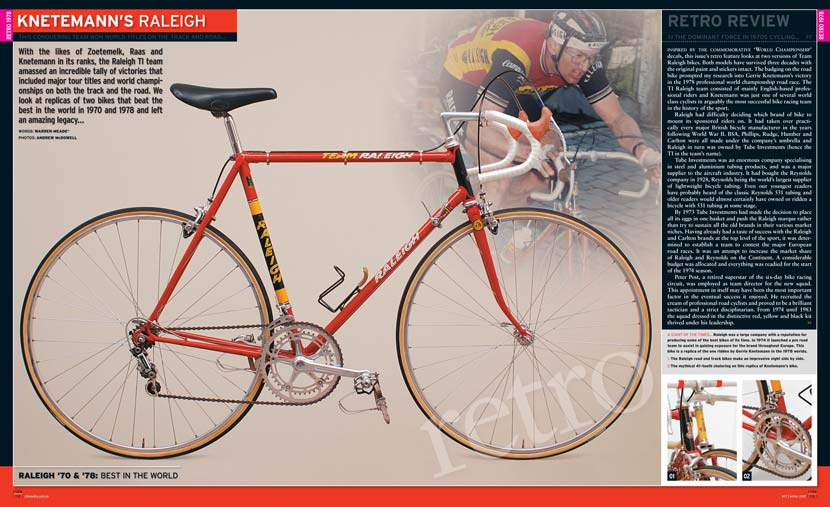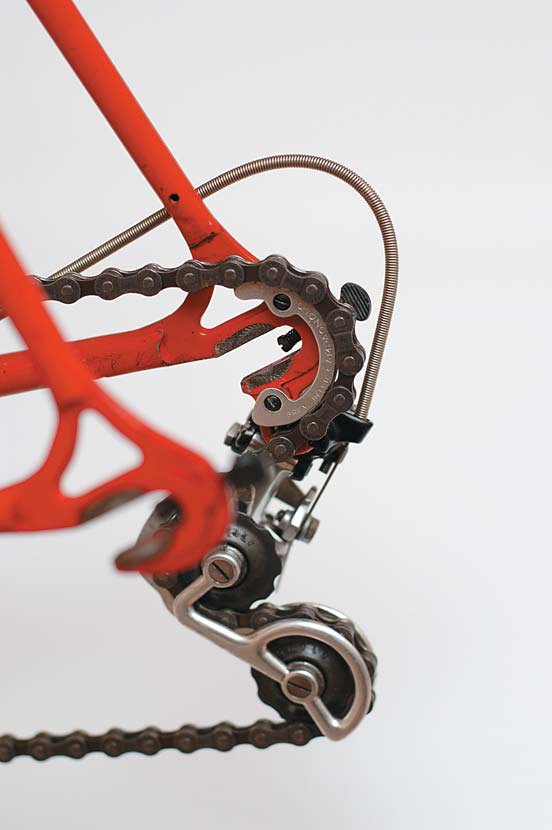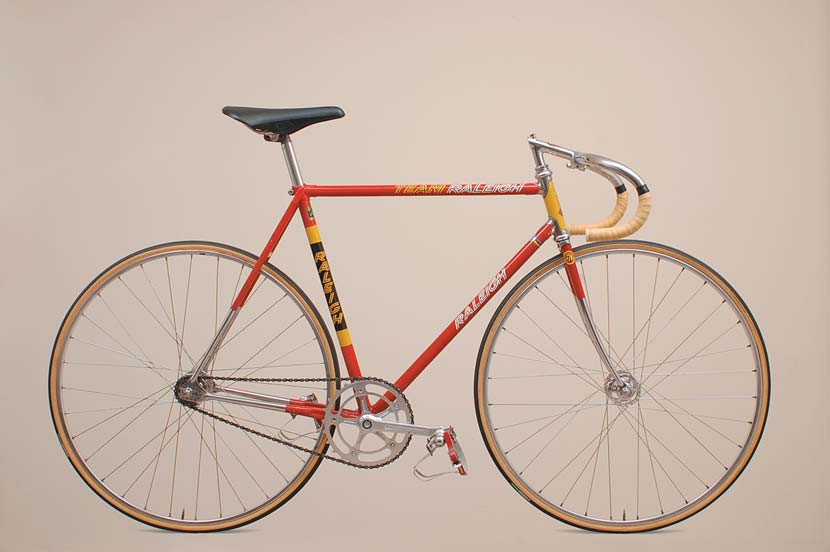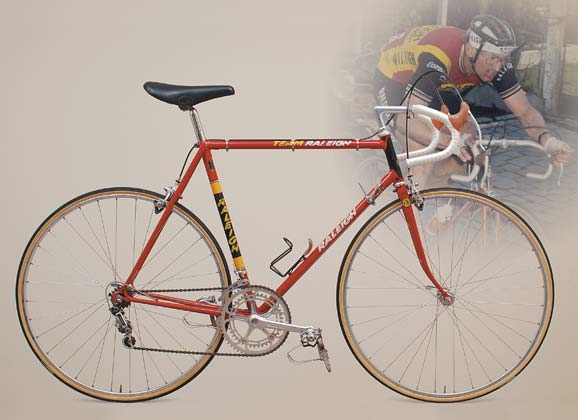It’s Friday. That’s as good as excuse as we need to delve into the archives and find an interesting bike to ogle. Raleigh is one of those brands that inspired a generation of cyclists. The exploits of many men riding these bikes made people cheer in the 1970s. All these years later, the orange and black still evokes memories of what Gerrie, Jan and Joop did way back when…
Here is a flashback to RIDE #37 (from July 2007) where we look at two replicas of Gerrie Knetemann’s Raleighs…
(Click the photo below to begin a slideshow of the Raleigh bikes…)
[ReflexGallery id=’146′]
This conquering team won world titles on the track and road…
With the likes of Zoetemelk, Raas and Knetemann in its ranks, the Raleigh TI team amassed an incredible tally of victories that included major tour titles and world championships on both the track and the road. We look at replicas of two bikes that beat the best in the world in 1970 and 1978 and left an amazing legacy…
– By Warren Meade (Photos Andrew McDowell)

The opening spread of the Retro Review from RIDE #37.
Inspired by the commemorative ‘World Championship’ decals, this issue’s retro feature looks at two versions of Team Raleigh bikes. Both models have survived three decades with the original paint and stickers intact. The badging on the road bike prompted my research into Gerrie Knetemann’s victory in the 1978 professional world championship road race. The TI Raleigh team consisted of mainly English-based professional riders and Knetemann was just one of several world class cyclists in arguably the most successful bike racing team in the history of the sport.
Raleigh had difficulty deciding which brand of bike to mount its sponsored riders on. It had taken over practically every major British bicycle manufacturer in the years following World War II. BSA, Phillips, Rudge, Humber and Carlton were all made under the company’s umbrella and Raleigh in turn was owned by Tube Investments (hence the TI in the team’s name).
Tube Investments was an enormous company specialising in steel and aluminium tubing products, and was a major supplier to the aircraft industry. It had bought the Reynolds company in 1928, Reynolds being the world’s largest supplier of lightweight bicycle tubing. Even our youngest readers have probably heard of the classic Reynolds 531 tubing and older readers would almost certainly have owned or ridden a bicycle with 531 tubing at some stage.
By 1973 Tube Investments had made the decision to place all its eggs in one basket and push the Raleigh marque rather than try to sustain all the old brands in their various market niches. Having already had a taste of success with the Raleigh and Carlton brands at the top level of the sport, it was determined to establish a team to contest the major European road races. It was an attempt to increase the market share of Raleigh and Reynolds on the Continent. A considerable budget was allocated and everything was readied for the start of the 1974 season.
Peter Post, a retired superstar of the six-day bike racing circuit, was employed as team director for the new squad. This appointment in itself may have been the most important factor in the eventual success it enjoyed. He recruited the cream of professional road cyclists and proved to be a brilliant tactician and a strict disciplinarian. From 1974 until 1983 the squad dressed in the distinctive red, yellow and black kit thrived under his leadership.
The frame of our featured road bike was produced in March 1979. It proudly displays a decal commemorating Raleigh’s victory in the team section of the 1977 and 1978 Tour de France, as well as individual honours in the 1978 professional road world championship. I have assembled this bike to represent the one used by Gerrie Knetemann in 1978. Usually riding within a star-studded cast in the Raleigh squad, the Dutchman was competing against his team-mates in the world championship road race that year. He proved that he was the strongest of them all.

The Portacatena was a brilliantly simple solution to the woes of rear wheel removal. One of the best bicycle innovations never to be adopted, it kept the chain tidy while cleaning or transporting.
The 1978 world championship road race was a typically tough affair with an added ingredient – atrocious weather. Knetemann outsprinted the only rider left with him at the finish, Francesco Moser, to win by a few millimetres after 273km. Moser had won the previous year’s world title and, thinking he had made it a second successive triumph, eased just before the line. He realised too late that Knetemann was making a last-ditch attempt to overtake him. Both riders threw their bikes at the finish, with Knetemann taking the narrowest of victories.
Knetemann won a total of 10 Tour de France stages in a tally of 127 victories as a professional rider. He was still going strong in 1986 when he won the Tour of Holland at the age of 35. Tragically he died of a heart attack at the age of 53 while riding with friends.
Our Team Raleigh road bike is equipped with Campagnolo Super Record components. The Super Record groupset featured titanium bolts in the rear derailleur, titanium axles in the pedals and a titanium bottom bracket axle with alloy cups. The bottom bracket axles were not a great success, and were known to fail a bit too often for comfort.
The Nuovo Record steel bottom bracket had been produced for over 20 years, was renowned for its durability and was only 105 grams heavier than its temperamental sibling. Consequently many riders chose the bulletproof and cheaper Nuovo Record assembly. I ride this bike and have opted for the titanium pedal axles (which are reasonably robust) although I use the steel bottom bracket.
A notable feature of this bike is the chain holder device, released by Campagnolo in 1977. Called the ‘Portacatena’ in the catalogues, it consisted of a special gear lever with an override clip. When activated this device allowed the chain to derail off the smallest cog onto a special ramp attached to the frame. This enabled the rear wheel to be removed and reinserted very easily, as the chain was kept on a ‘false cog’ while the wheel was out. The device worked extremely well and made wheel changes faster and much more reliable, especially under the pressure of race conditions.
Unfortunately for Campagnolo and future road bike users the Portacatena was not widely adopted, even when new, as it required an extra five millimetres of rear axle spacing. No sooner had the mechanics fitted a longer axle and built the frame to 130mm to allow for it than seven-speed clusters appeared on the horizon. Another option was to resort from a six-speed set-up to a five-speed version while retaining the longer axle. Faced with the option of having an efficient wheel change or an extra rear cog, most riders opted for the extra cog.
Of all the innovations that didn’t survive, this is the one that should have. If it could be integrated into current shifting systems it would make life a lot simpler for everyone, especially novice and recreational riders who are spooked by the thought of removing the back wheel of their bike.
This particular frame was purchased in Holland in 1979 by Australian rider Brad Collis who had followed his two brothers to Europe to race as an amateur. Collis bought the bare frame and fork back to Australia as part of his luggage. At the time it was possibly the most recognisable and desirable bike a serious enthusiast could own. He built the frame up in 1980 and raced it for a couple of seasons. That same year the Raleigh magic continued when Joop Zoetemelk won the Tour de France at the age of 33 after attempting it nine times and finishing second on five occasions.
As a portent of things to come in the bicycle industry this bike was originally built up with Campagnolo hubs and head fittings. Most of the parts, however, were supplied by the new kid on the block, Shimano’s Dura-Ace. And like virtually all racing cyclists at that time, including myself, the lack of provision on the frame for fitting the Portacatena device went unnoticed and unlamented.
Raleigh pioneered the use of Reynolds 753 tubing in its team bikes in 1976. This was the first major switch to its lightweight tubing since the introduction of Reynolds 531 in 1935. Saving approx 380 grams on a 56cm frame, ‘753’ was considered extremely light at the time. The Raleigh custom frame facility produced road frames using either 531 or 753, the latter being considerably more expensive.
The 753 Raleigh team bikes equipped with Campagnolo Super Record were highly desirable machines in the late 1970s and remain so as a collector’s item today. A 56cm Reynolds 753 frame weighs approximately 1,650 grams and the fork comes in at 700 grams for a total of 2,350 grams. This is about 1kg heavier than the most exotic carbon-fibre frame and fork combinations but not embarrassed by entry-level frame weights for most 2007 models. The complete bike with Reynolds 531 tubing weighs exactly 9kg without pedals. The lightest team version with Reynolds 753 tubing and titanium bottom bracket axle weighed 8.5kg.

This bike was essentially a Carlton Cycles frame but belonged under the Raleigh banner due to the English company’s purchase of many smaller brands and subsequent dominance of the British cycling scene in the 1970s.
Australian track sprinter Gordon Johnson was also a member of the Raleigh TI squad. A couple of years before the 1970 track world championships Johnson had signed for Carlton Cycles. He confirmed the faith in him in the most emphatic fashion by winning the professional sprint world championship at his first attempt. At the time Raleigh was promoting Carlton as its lightweight premium brand. So while Gordon Johnson won his world championship aboard a Carlton branded machine his performances were used to advertise Raleigh products generally.
The following year Johnson won the Australian professional sprint championship but was runner-up at the worlds to Leijn Loevesijn of the Netherlands. The Raleigh/Carlton management would not have been too disappointed with Johnson’s silver medal as Loevesijn also rode for them. This gave Raleigh a perfect one-two result in the final. The track bike featured on this page was built in January 1975 and bears the commemorative ‘World Sprint Champion 1970-71’ decal in honour of Johnson’s and Loevesijn’s successes.
Raleigh discontinued its sponsorship in 1983. The team had amassed a total of 77 major tour stages, 15 world championships, 37 Classics victories and 55 national titles. Add to this tally thousands of successes for elite amateur and club riders aboard the team replica bikes and you can appreciate the legacy left by Raleigh.
– By Warren Meade



